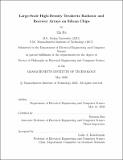Large-scale high-density terahertz radiator and receiver Arrays on silicon chips
Author(s)
Hu, Zhi,Ph. D.Massachusetts Institute of Technology.
Download1191625378-MIT.pdf (10.93Mb)
Other Contributors
Massachusetts Institute of Technology. Department of Electrical Engineering and Computer Science.
Advisor
Ruonan Han.
Terms of use
Metadata
Show full item recordAbstract
Electromagnetic (EM) waves in the terahertz (THz) frequency range (usually deαned as from 10⁻¹ THz to 10¹ THz) have important applications in gas sensing, non-invasive imaging, short-range ultra-high-data-rate wireline/wireless communications. Historically, due to their speed limit, silicon-based transistors are unable to reach this frequency range, so terahertz systems were built upon high- cost custom-made devices, which limits their application space. Currently, thanks to Moore's law, the f[subscript max] of many transistors in commercially-available processes have reached the terahertz region, making generating terahertz waves from DC on low-cost chips possible, but due to limited gain, generating high-power terahertz waves is still a challenge. Fortunately, the bright side, also unique to the terahertz frequency range, is that, given the small wavelengths of terahertz waves, there exists the on-chip option of expanding a standalone on-chip antenna-integrated terahertz transmitting/receiving circuit block to a large-scale two-dimensional array of such circuit block, with tera-hertz signals central to the operation of these blocks coherently coupled between all array elements. By doing so, for radiators, the total radiated power can be increased, for heterodyne detectors, the detection sensitivity improved, and for both cases, the beam directivity increased. The above argument has outlined the possibility of such an array building solution from the antenna dimension's point of view, and it remains to be shown how such a solution is technically realizable - this is the primary goal of this thesis. The major obstacle of implementing 2D dense terahertz arrays comes from the apparent "conflict" between the array element area limit dictated by the antenna spacing requirement and the large footprint of typical terahertz circuits. To this end, EM-circuit co-design approaches of realizing compact and multi-functional array elements are proposed. Based on these approaches, two chip prototypes were realized. The αrst chip is a 42-element two-dimensional resonator-coupled oscillator array with 91 harmonic-selective antennas for high-power 1 THz signal generation, which has demonstrated the highest total radiated power (7 dB higher than the state of the art) and highest equivalent isotropically radiated power (23 dB higher than the state of the art) among all radiators near 1 THz. The second one is a 32-element phase-locked two-dimensional local-oscillation-signal-coupled 240-GHz heterodyne detector array equipped with compact self-oscillating mixers. It has achieved ~ 1200x sensitivity improvement and 4x scale increase compared to the state-of-the-art terahertz heterodyne receiver array.
Description
Thesis: Ph. D., Massachusetts Institute of Technology, Department of Electrical Engineering and Computer Science, May, 2020 Cataloged from the official PDF of thesis. Includes bibliographical references (pages 139-145).
Date issued
2020Department
Massachusetts Institute of Technology. Department of Electrical Engineering and Computer SciencePublisher
Massachusetts Institute of Technology
Keywords
Electrical Engineering and Computer Science.